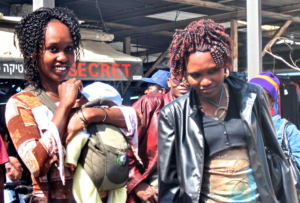Africa’s Beauty Industry is Booming with Potential
 Although the COVID-19 pandemic has caused a severe setback in consumer spending in Africa, data shows that historically, sub-Saharan Africa has been in a much better economic standing than before COVID-19. Consumer spending in 1981 was $145.64 billion, whereas in 2021 it was over $1.2 trillion. This is a stark difference. Overall, there has been a 3.9% compound annual growth rate (CAGR) in consumer expenditure in Africa since 2010 and this momentum shows no signs of stopping. An industry that is exploiting the enormous market potential of 1.7 billion people is Africa’s beauty industry. The market growth in the industry is estimated to be $1.26 billion between 2020 and 2025, with a CAGR of 2%.
Although the COVID-19 pandemic has caused a severe setback in consumer spending in Africa, data shows that historically, sub-Saharan Africa has been in a much better economic standing than before COVID-19. Consumer spending in 1981 was $145.64 billion, whereas in 2021 it was over $1.2 trillion. This is a stark difference. Overall, there has been a 3.9% compound annual growth rate (CAGR) in consumer expenditure in Africa since 2010 and this momentum shows no signs of stopping. An industry that is exploiting the enormous market potential of 1.7 billion people is Africa’s beauty industry. The market growth in the industry is estimated to be $1.26 billion between 2020 and 2025, with a CAGR of 2%.
Africa’s Burgeoning Youth and Urbanization
High fertility rates coupled with lower mortality rates have led to Africa having the world’s youngest population. About 70% of sub-Saharan Africa’s population is less than 30 years old. Beauty and personal care products are favored by a younger demographic, who want to invest in fashion trends and their looks. This gives Africa the perfect leverage to boost its beauty and cosmetics industry.
It is estimated that by 2025, 45% of Africa’s population will be living in urban areas. According to McKinsey & Company, “per capita consumption spending in large cities in Africa is on average 79% higher at the city level than at the national level.”
Furthermore, as the country continues to develop, there is a shift from spending in informal markets (e.g., roadside stalls) to spending in more formal sectors, such as department stores, supermarkets, etc, according to Brookings. This is boosting beauty product sales.
Higher Purchasing Power
Over the last three decades, Africa’s middle class has tripled in size. By 2025, roughly 65% of African households will be earning more than $5,000, according to McKinsey & Company.
The increase in the number of people in the “discretionary spending income bracket” is likely to result in consumers increasing their spending on luxury items. This shift may also be due to a growing sense of personal hygiene among people and realizing the significant role that products such as soap, shampoo, etc. play in it. Africa’s beauty industry may help customers to realize and fulfill their body care goals.
It is no surprise that Africa’s beauty industry mainly caters to and is dominated by women. Greater access to education and high-paying jobs have increased the disposable income of African women. According to Beauty Africa, “…a significant chunk of [their] spending goes to the beauty and personal care products.”
Growth of E-Commerce
The GSM Association projects that by 2025, 615 million sub-Saharan Africans will subscribe to mobile services, 28% will have a 4G connection and 3% will have a 5G connection.
This will allow consumers to make electronic payments. In fact, mobile money “is growing five times faster in Africa than in any other region,” according to McKinsey & Company.
The evolution of e-commerce and fintech has made purchasing beauty products faster and easier. Additionally, technological advancements allow companies to better track market trends and profile customers, according to The Exchange.
Key Market Players
Nigeria’s beauty industry is attracting foreign direct investment because of its growing modern, fashion-conscious, female population. Her Imports, a U.S.-based hair-extension company, opened an outlet in Lagos, Nigeria in 2014. Patrick Terry, the CEO, said that their products were “performing sensationally in Africa,” according to Africa Business Pages.
According to The Guardian, the projected income for Her Imports from Africa “topped $100 million.”
South Africa is also a key market player. Between 2020-2025, it is expected that 53% of the market growth in Africa’s beauty industry will come from South Africa.
Many international companies are only now realizing Africa’s untapped potential. On May 27, 2022, global pop star Rihanna launched her beauty line, Fenty, in “South Africa, Botswana, Ghana, Kenya, Namibia, Nigeria, Zambia and Zimbabwe.” The launch of this premium brand comes as great news for African women who wanted a better representation of their skin tones.
Infrastructure and Poverty Alleviation Projects Helping
Infrastructure helps connect supply-demand chains, allows goods and services to move easily across borders and enhances overall efficiency in the production and consumption system. Improved infrastructure in the beauty and personal care industry not only generates more employment but also hikes up the sector’s growth rate, according to The Exchange. This increase in growth in turn attracts more investments for additional upgrades in infrastructure. This forms a continuous cycle that ultimately boosts the economic growth of Africa’s beauty industry.
Poverty alleviation projects could help people climb to the middle-income group and have greater purchasing power. Also, closing the gender gap and providing more women with education and equal opportunities could help them to earn income and spend it on the beauty and cosmetics market.
More private investment, advanced technology, improved infrastructure and greater contributions to poverty alleviation projects could help expand Africa’s beauty industry while keeping in line with United Nations Sustainable Development Goals and the African Union’s Agenda 2063.
– Anushka Raychaudhuri
Photo: Flickr
